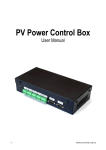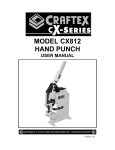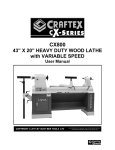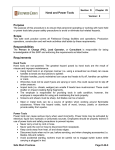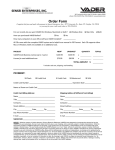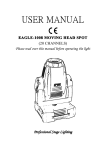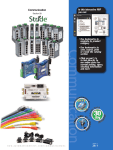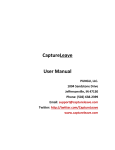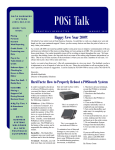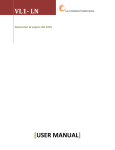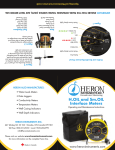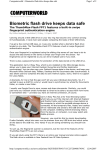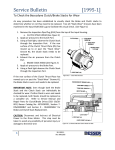Download Hand and Power Tool Safety Guide
Transcript
Environmental Health and Safety Office 4400 University Drive, MS 5E2; Fairfax, VA 22030 Telephone: (703) 993-8448 Fax: (703) 993-8996 HAND AND POWER TOOL SAFETY GUIDE Version 3 Date August, 2011 Comments Hand and Power Tool Safety Guide A. SUMMARY The purpose of this Guide is to explain the common hazards associated with using hand and power tools, and safety precautions to take in order to prevent injuries. This Guide is based upon the Occupational Safety and Health Administration (OSHA) Standards 29 CFR 1910, Subpart P: Hand and Portable Powered Tools and Other Hand-Held Equipment sections 1910.241, 1910.242 and 1910.243. B. SCOPE This Guide applies to all University employees who use hand and power tools. It covers the minimum responsibilities of users and supervisors with regard to hand and power tool regulations, hazards, and usage. C. RESPONSIBILITIES • • • Users must properly inspect, use, and maintain hand and power tools in accordance with this Guide and manufacturer’s directions. Users or supervisors must remove damaged or malfunctioning hand and power tools from service until repaired. Supervisors are responsible for ensuring that hand and power tools are maintained in a safe condition, including those furnished by employees, students, contractors, or visitors. D. GENERAL SAFEETY RULES FOR HAND AND POWER TOOLS Hazards involved in the use of hand and power tools can be mitigated by following five basic safety rules: • • • • • • Keep all tools clean and in good condition with regular maintenance. Use the right tool for the job. Examine each tool for damage before use to include power cords and attachments. Operate tools according to training and the manufacturer’s instructions. Use proper personal protective equipment (PPE) when operating a hand or power tool. Eye protection and work gloves should be worn at all times. Environmental Health and Safety Office August 2011 1 E. HAND TOOLS Hand tools are non-powered tools (i.e. axes, wrenches, screwdrivers, hammers, chisels, knives, scissors, and saws) which require manual operation. Hazards posed by hand tools typically result from misuse and improper maintenance. Injuries often result when a hand tool breaks during use due to improper application or damage. Safety Precautions for all Hand Tools: • Inspect hand tools and accessories for damage, cracks, missing pieces, and proper grips. • If a defect is discovered the tool must be placed in an “out of service” unit until it is repaired or discarded. Defective or damaged tools must be marked with the words “Out of Service, Do Not Use.” • Keep cutting edges sharp. • When using saw blades, knives, or other sharp tools, direct the tool away from the body and away from the direction of other employees working in close proximity. • Do not use hand tools that can cause sparks around flammable materials or in spaces that may contain a flammable atmosphere. Use brass, plastic, or aluminum tools to prevent sparks. • Floors should be kept as clean and dry as possible to prevent accidental slips with or around hand tools. • Do not use excessive force to operate a hand tool (i.e., hit with a hammer or strike against work unless so designed). F. POWER TOOLS Power tool type is determined by the power source that they use; electric, pneumatic, liquid fuel, hydraulic, or powder driven. Power tools, if used improperly, can cause serious injury from moving parts, cutting edges, accidental release, contact with the power source, or loss of control. All power tools are required to meet the following conditions: • • • To protect employees against shock, electric power tools must have a: o Three-wire cord with ground and be grounded (plugged into a grounded socket); o Be double insulated; or o Be powered by a low-voltage isolation transformer. Tools must have a constant pressure operating control that will shut off power when pressure is released (e.g., trigger or button). The operating control must be constructed or guarded to minimize the possibility of accidental operation. Safety Precautions for all Power Tools: • Inspect power tools and accessories prior to use for missing parts, guards or shields, grips, or other damage such as frayed or damaged electrical cords or belts that may affect operation. • If a defect is discovered the tool must be placed out of service until it is repaired or discarded. Out of service tools must be marked with the words “Out of Service, Do Not Use.” Environmental Health and Safety Office August 2011 2 • • • • • • • • • • • • • • Face protection must be worn when the face is exposed to flying particles. Wear work gloves capable of protecting against cuts and punctures. Wear appropriate clothing that fits correctly and is free of loose material. Confine loose clothing, ties, long hair, or jewelry that can become caught in moving parts. Wear sturdy, closed-toe footwear. Establish good footing and maintain good balance while working. Never carry a tool by the power cord, hose, or working point (e.g., blade, bit, disc, etc.). Do not place your finger on the operating control while carrying a plugged-in tool to prevent accidental operation. Place your finger on the operating control only when you are ready to begin operation. Do not use power tools around flammable materials or spaces that may contain a flammable atmosphere. Keep cords and hoses free of kinks and away from heat, oil, and sharp edges. Secure work with clamps or a vise, thereby freeing both hands to operate the tool. Never place a portable power tool in a vice or clamp to perform work. Follow instructions in the user’s manual for maintaining and changing accessories. Stop using the tool immediately if an odd noise, excessive vibration, or unusual operation/performance occurs. Disconnect tools when they are not in use, before servicing, and when changing accessories. Disconnect tools from power sources by hand at the connection point. Never pull the cord or hose to disconnect it from the socket. Keep observers at a safe distance away from the work area. Hazards and safety precautions may differ depending on which type of power tool is used. For specific information regarding hazards, safety precautions, and user instructions for certain types of hand and power tools, please refer to the manufacturer’s user guide/instructions or contact EHS. G. GUARDS The exposed moving parts of power tools must be guarded. All power tools must be equipped with the appropriate guard supplied or recommended by the manufacturer to protect the operator and others from point of operation, in-running nip points, rotating parts, exposed belts, and flying chips and sparks. Guards may never be removed or defeated when a tool is being used. H. CLEANING TOOLS Tools must be kept clean to keep contaminants and materials from disrupting moving parts and power sources. Clean tools with a cloth, solvent, or other appropriate material as prescribed by the manufacturer’s user/instruction manual. Compressed air cannot be used for cleaning purposes unless: • Compressed air pressure has been reduced to less than 30 psi; • Effective chip guarding is in place; and • Proper PPE is utilized (e.g., safety glasses and work gloves). Environmental Health and Safety Office August 2011 3 I. TOOL SPECIFIC OPERATING PROCEDURES Pneumatic Powered Tools: • A tool retainer must be installed on each tool or tool accessory that may accidently eject during operation. • All hoses powering pneumatic tools must be designed to withstand the pressure required to operate the tool. Cut or damaged pressure hoses must be replaced before beginning work. • Hose and tool fittings may not be damaged and must fit together correctly. • Do not expose hoses to solvents, excessive, heat, or allow them to come in contact with sharp objects, moving machinery parts, or other equipment that may damage the hose. • If the air hose is more than ½ inch in diameter, a safety excess flow valve must be installed at the source of the air supply to reduce pressure in the event of a hose failure. Portable Abrasive Wheel Tools: (Grinders, excluding sandstone, wooden, cloth, or paper disc): • Before installing a wheel ensure that the spindle speed of the machine does not exceed the maximum operating speed marked on the wheel. Ensure the wheel is properly sized and fits correctly on the spindle. • Inspect the abrasive wheel before installation and use by using the “ring test”. Tap the wheel with a non-metallic instrument (handle of a screwdriver). An intact wheel should ring or ping, a cracked wheel will sound “dead” or muffled. If a crack is discovered the wheel must be discarded and replaced. • A guard (180 degree coverage or greater) must be installed that covers the top half of the abrasive wheel and must be used in a position such that the guard is placed in-between the user and the abrasive wheel. The guard must also cover the nut, spindle end, and flange projections of the abrasive wheel. • A revolving cup guard may be used for cup wheels, however the clearance between the wheel side and guard may not exceed one-sixteenth (1/16) of an inch. • Never clamp a hand-held grinder in a vise. Portable Circular Saw: • An upper guard must be provided that covers the saw teeth except for the minimum arc required to permit the base to be tilted for bevel cuts. • A lower guard must be provided that retracts to allow cutting but automatically and instantly returns to the covering position when withdrawn from the work piece. Drills: • Do not attempt to hand-hold the stock while drilling; use a hold-down fixture (vises or clamps) to secure work. Jig Saws: • Guard the blade with an adjustable or self-adjusting guard; the portion of the blade below the stock being cut should be guarded. • Allow the blade to come to a complete stop before removing the saw from the stock. Environmental Health and Safety Office August 2011 4 Belt Sanders: • Guard the unused run of the sanding belt against accidental contact. Guards must prevent the operator’s hands or fingers from coming in contact with nip points. The guard may consist of a protective cover at the rear side of the wheel and a hinged cover around the wheel periphery. • Sand on the downward-moving side of the disk or belt. • Replace torn, frayed, or excessively worn belts. Orbital Sanders: • Keep hands away from abrasive surfaces; sand on the downward-moving side of the disk. • Replace torn, frayed, or excessively worn belts. Nail Guns: • Nail guns that operate at pressure more than 100 pounds per square inch must be equipped with a special device to keep fasteners from being ejected, unless the muzzle is pressed against the work surface. • Check nail guns to see that they are fastened securely (with a short wire or positive locking device) to the air hose to prevent them from becoming disconnected. • Never point a nail gun towards anyone. Never “dead-end” a nail gun against yourself or anyone else. • Wear appropriate eye and hearing protection when working with nail guns; head and face protection is recommended. • Set up screens to protect nearby workers from being struck by flying fragments. The information contained in this Guide is not inclusive of all OSHA regulations. Please contact Environmental Health and Safety Office at (703) 993-8448 or visit www.OSHA.gov for more information regarding workplace hazards, safety precautions, and regulations. Environmental Health and Safety Office August 2011 5





